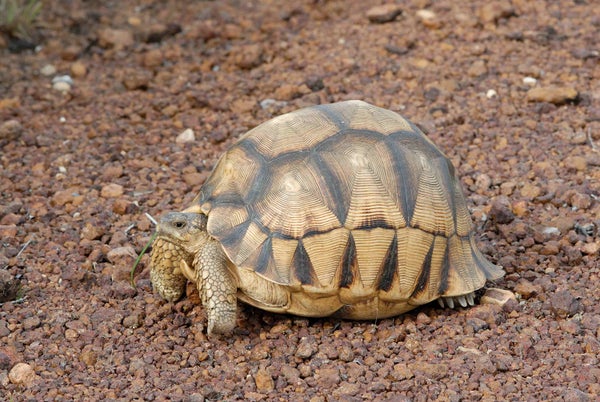This article was published in Scientific American’s former blog network and reflects the views of the author, not necessarily those of Scientific American
The ploughshare tortoise (Astrochelys yniphora) could be extinct in the wild in as little as two years if the government of Madagascar does not immediately step up and take action to protect them.
That stark warning, from a quintet of conservation organizations, came this week as government representatives gathered in Johannesburg for the triennial meeting of the parties of the Convention on International Trade in Endangered Species (CITES). Protecting the ploughshare tortoise is just one of many items on the agenda for the 12-day event.
Also known as the Angonoka tortoise, the ploughshare is one of the rarest turtle species on the planet, which makes it even more valuable to collectors, who keep the animals as luxury “pets.” As a result, poaching of these turtles has come close to wiping the species out at its only wild habitat, Madagascar’s Baly Bay National Park. Back in 2013, the wild population was estimated at 400 to 600 tortoises. Now the conservation organizations warn that the population has fallen to fewer than 100 mature animals and that poaching levels have reached their highest levels to date.
On supporting science journalism
If you're enjoying this article, consider supporting our award-winning journalism by subscribing. By purchasing a subscription you are helping to ensure the future of impactful stories about the discoveries and ideas shaping our world today.
All of this has gone on right under the noses of the Malagasy authorities. As a result, the five conservation groups—the Wildlife Conservation Society, Durrell Wildlife Conservation Trust, Turtle Survival Alliance, Turtle Conservancy and Global Wildlife Conservation—are calling on the government of Madagascar to finally start enforcing its existing anti-poaching and anti-trafficking laws. “At this point the fate of the tortoise is up to the government of Madagascar,” Peter Paul van Dijk, the Turtle Conservancy’s field conservation programs director, said in a prepared statement. “Conservationists can’t go in and be the police force or the customs official or the border inspections officer at the airport.”
Why is this international meeting the opportunity to bring this up? The species is already listed on CITES Appendix 1, which means that all international trade in the tortoises is currently banned among the treaty’s signatories. Still, the groups say this is an opportunity to draw attention to the crisis, get the world’s attention, and hopefully inspire collaboration between Madagascar and the countries to which the tortoises are being smuggled.
Most importantly, however, they want to get Madagascar’s attention. “At the end of the day, it is up to Madagascar to seize these opportunities and take control of this trade,” said Richard Lewis, director of Durrell Wildlife Conservation Trust’s Madagascar program.
It’s no surprise that Madagascar hasn’t had much luck protecting these tortoises. Madagascar one of the ten poorest countries in the world and the site of tumultuous political upheaval over the past few years, none of which ever seems to get much notice by the international community. Will this international attention be enough to help turn the tide, if not for the whole country but for at least one of its rarest endemic species? I guess we’ll know the answer to that in about two years.
Previously in Extinction Countdown:
How Poachers Stole 10% of an Entire Tortoise Species...and What Happened Next
Crisis in Madagascar: 90 Percent of Lemur Species Are Threatened with Extinction
25 Possible New Extinctions: Hawaiian Plants, Madagascar Orchids, Chilean Water Frog
Climate Change Could Wipe Out Amazing Baobab Trees in Madagascar
